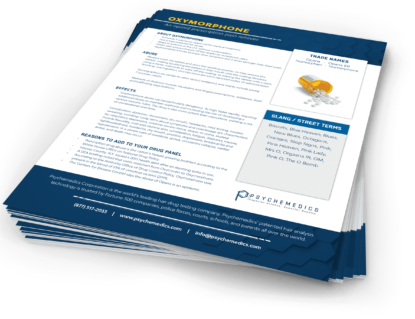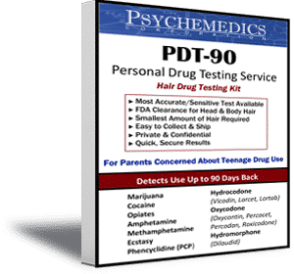OPIATES/OPIOIDS HAIR DRUG TESTING
Opiates/Opioids - A Family At The Center Of An Epidemic.
What Are Opiates/Opioids?
Description
The brain’s opioid receptors are largely responsible for the sensations of pleasure and pain and the opioids are all drugs in a class that act on those receptors. While opiates are naturally-occurring chemicals in the Flowering Opium Poppy, opioids are man made. The two words are sometimes used interchangeably but an important distinction to remember is that while all opiates are opioids, not all opioids are opiates. A Psychemedics opiates hair drug testing program will deliver almost certanity of detection if opioid abuse is occuring.
Morphine and Codeine are opiates, derived from the poppy plant and are commonly prescribed to manage pain.
Heroin is a highly addictive drug derived from morphine, which is obtained from the opium poppy. It is a “downer” or depressant that affects the brain’s pleasure systems and interferes with the brain’s ability to perceive pain.
Oxycodone / Hydrocodone / Hydromorphone are prescription pain relievers.

Contact Psychemedics Today
Analytes
Codeine
Morphine
6-MAM (Heroin)
Oxycodone (OxyContin, Endocet®, Endodan®, Percoset®, Percodan®,OxyFast®, OxyIR®, Roxicet® Tylox®)
Oxymorphone (Numorpha®, Opana®)
Hydrocodone (Vicodin®, Lortab®, Lorcet®, Hycodan®)
Hydromorphone (Dilaudid)
Street Names / Slang Terms
Heroin — Black Tar, Poppy, Al Capone, Brown Crystal
Codeine — Empirin compound with codeine, Tylenol with codeine, Codeine in cough medicine
Morphine — Morph, Monkey, Pectoral Syrup, Duramorph
OxyContin — Hillbilly Heroin, 80, Oxy, OCs, Ox, Pills, 40, 40-Bar, Kicker, Cotton
Trade Names for Oxycodone — Tylox, Percodan, Oxycontin
Vicodin — Vikings , Vikes, Hydros, Watson387
Trade Names for Hydrocodone / Vicodin — Lortab, Lorcet, Hycodan, Vicoprofen
Dilaudid — Hospital Heroin, Dillies, Hydro, M2, Dust, Juice, Smack, Footballs, D
What Do Opioids Look Like?
Opioids are a broad family and come in many forms.
Morphine is available in pill, oral liquid, or injectable forms.
Codeine is available in pill, oral liquid ,or as a suppository.
Heroin’s appearance can vary dramatically. The most familiar form is a powder ranging from white to off-white to brown to grey. However, another form, black tar heroin, is a sticky black substance. Recently, heroin packaged in gel caps called “scramble” and heroin tablets are being found more often.
The remainder of the opioids are found in a variety of tablet forms or injectables that vary from manufacturer to manufacturer.
How are opioids used?
Heroin can be injected into a vein (“mainlining”), injected into a muscle, smoked in a water pipe or standard pipe, mixed in a marijuana joint or regular cigarette, inhaled as smoke through a straw, known as “chasing the dragon”, or snorted as powder via the nose.
Morphine / Codeine – Depending on its form, it may be injected, swallowed, smoked or even used as a suppository.
Oxycodone / Hydrocodone / Hydromorphone are swallowed as pills or injected.
Heroin is sometimes mixed with cocaine and is called a "speedball".
Fast Facts About Opioids/Opiates
Why Choose Psychemedics for Opioids Hair Drug Testing?
Unrivaled Detection. Nobody Is Better.
Although the growth in usage and deaths are beginning to trend slightly down, the sheer scale of the opioid problem will be staying with us for the foreseeable future. While prescribed opioids are down, Illicitly Manufactured Fentanyl (IMF) is available and inexpensive. This leads to dealers finding a powerful profit motive to cut mainstream drugs with these sedatives and usage is skyrocketing. The potential for addiction is extreme and the possibility of overdose or death is there.
A Psychemedics hair drug testing program for opiates delivers almost certainty of detection. Our opioid test detects usage from the previous 90-days and the test is fully observed. This leads to less opportunities for evasion, and the most high-risk drug behaviors can easily be identified.
Detection is the first step toward Deterrence.
Psychemedics have detected more drug users for companies than any other opiates hair drug testing lab in the world, hence our results have been accepted by courts across the country. Contributing to our unequaled legal track record, we are the only hair drug test with safeguards validated by the FBI. As a result, this protects those tested from false-positive results by differentiating between ingestion versus external exposure to a drug. Therefore, our clients confidently make policy decisions knowing that we go the extra mile to ensure fairness to those tested.
Our non-invasive opiates hair drug testing procedure uses a sample of hair that is up to 60% less than those required by other hair testing labs. Therefore, making the sample easily collected and shipped to our College of American Pathologists (CAP) ISO-IEC 17025:2005 certified laboratory. Thus, turnaround on most results is the best in the industry.
Keep Current On Drugs Of Abuse
We have put together an information sheet on Oxymorphone, a member of the opioids family, to help you understand the threats and recognize the symptoms of abuse. You can download the document for your reference by clicking the button below.

More Information About Opiates/Opioids
Short Term Effects
Heroin — The short-term effects of heroin abuse can appear as soon as after a single dose and can disappear in as little as a few hours. After an injection of heroin, the user reports feeling a surge of euphoria (“rush”) accompanied by a warm flushing of the skin, a dry mouth, and heavy extremities. Following this initial euphoria, the user goes “on the nod”, an alternately wakeful and drowsy state. Mental functioning becomes clouded due to the depression of the central nervous system. Furthermore effects include slowed and slurred speech, slow gait, constricted pupils, droopy eyelids, impaired night vision, vomiting, and constipation.
Morphine / Codeine — can also produce drowsiness, cause constipation, and, depending upon the amount taken, depress breathing. Taking a large single dose could cause severe respiratory depression, coma, or death.
Oxycodone / Hydrocodone / Hydromorphone — Relief from pain. In some people, prescription pain relievers also cause euphoria or feelings of well being by affecting the brain regions that mediate pleasure. This is why they are abused. Other effects include drowsiness, constipation, and slowed breathing. Taking a large single dose of prescription pain relievers can cause severe respiratory depression that can lead to death. Use of prescription pain relievers with other substances that depress the central nervous system, such as alcohol, antihistamines, barbiturates, benzodiazepines, or general anesthetics, increases the risk of life-threatening respiratory depression.
Long Term or Extreme Effects
Heroin — Chronic users may develop collapsed veins, infection of the heart lining and valves, abscesses, cellulites, and liver disease. Pulmonary complications, including various types of pneumonia, may result from the poor health condition of the abuser, as well as from heroin’s depressing effects on respiration. Withdrawal, which in regular abusers may occur as early as a few hours after the last administration, leads to drug craving, restlessness, muscle and bone pain, insomnia, diarrhea and vomiting, cold flashes with goose bumps (“cold turkey”), kicking movements (“kicking the habit”), and other symptoms.
Morphine / Codeine — Long-term use of morphine also can lead to physical dependence. This can also include tolerance and addiction.
Oxycodone / Hydrocodone / Hydromorphone — Taken exactly as prescribed, pain relievers can manage pain effectively. But chronic use or abuse of opioids can result in physical dependence and addiction. Dependence means that the body adapts to the presence of the drug, and withdrawal symptoms occur if use is reduced or stopped. Symptoms of withdrawal include: restlessness, muscle and bone pain, insomnia, diarrhea, vomiting, and cold flashes with goose bumps (“cold turkey”). Tolerance to the drugs’ effects also occurs with long-term use, so users must take higher doses to achieve the same or similar effects as experienced initially. Addiction is a chronic, relapsing disorder characterized by compulsive drug seeking and use.

Buy Our PDT-90 AT Home Drug Testing Kit Today
Parents can administer the test in the privacy of their own homes. Just collect a small sample of a child’s hair, send the sample to the Psychemedics laboratory and receive notification of the results within 3-5 business days of receipt of the sample at the laboratory. The ‘PDT-90’ includes all instructions plus a pre-paid mailing envelope for the sample. No names are used so complete confidentiality is assured.
$89.95 - Plus Free Shipping
Drug News You Can Use
Sign up for our quarterly newsletter to stay up-to-date with snapshots of usage statistics, information on the latest trends, and updates on detection science.



